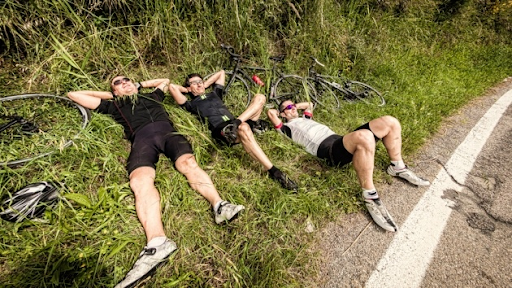Quintuple Iron – Sleep Tactics
As a follow up to the Quintuple Iron training tips many of you have asked for specific advice related to sleep strategies for the race. The following guidelines might assist with your race planning.
There are many variations to planning a sleep schedule, but typically it comes down to three main approaches:
- Multiple short and condensed napping, averaging 30 minutes to 2 hours.
- Longer sleep of 3-5 hours but less frequent than the napping strategy.
- Go as long as possible until beginning to falling asleep on the bike or run.

An event as long as the Quintuple Iron with significant fatigue is quite different than a 2-day event. The resting time is more about being off one’s feet or riding in most cases than actually getting multiple hours of REM sleep. It’s quite difficult to get a lot of REM sleep when you move around while trying to fall asleep and are immediately woken up because of the sore legs, back, neck and arms.
Cramps when sleeping are a big factor and it’s not always the quads and calves that start seizing up. Many times depending upon the exact sleeping location (crawling into a tent, car or sleeping on a mattress in a covered building) cramps can occur in the abdominal area. They can be debilitating and very painful. It’s important to not jerk your body around to get into a shelter and keep mustard packets, electrolytes and sugar drinks close by.

One thing about sleeping strategies is that you can tweak and re-test them as you gain experience. Just like so many items in long endurance races, experience will help over time. For example, over time you will notice that you can go longer without sleeping or stopping and realize especially on the bike that you can go much longer without sleep as long as nutrition and caffeine are managed effectively. If you decide that the longer sleeps vs. shorter naps works best for you with regards to energy levels make sure you push the overall pace to make up for the additional sleep.
If we look at other longer races like RAAM or the DECA, many athletes will start out with a strategy of racing 24-36 hours with no sleep then begin a sleep plan. Personally as I have gained more experience, I have moved toward shorter naps vs. longer sleeps. Keep in mind if you are racing your competitors (or crews) will be looking at your sleeping patterns. They might make it noticeable but I can guarantee that they are when they look at the leader-board. It’s important to always focus on your own race first of course but as the race gets to the last 25-30% of total time you will have a tendency to reduce sleep to hold off another athlete or just want to get to the finish line as quickly as possible!

Remember the following 4 Tips:
- Bring a loud alarm clock or make sure your Smart phone alarm is set to the maximum volume.
- Crew members should have a backup alarm to wake you up. They must be forceful and eliminate feeling sorry for you and letting your rest longer. It’s imperative that they get you up and moving.
- Your crew may be sleep deprived and must realize they are there for you and leave their ego behind and number one goal is to keep you moving and watching your sleep patterns.
- Always have either a bucket or water bottle (for men) close by in your tent during your sleep breaks; it’s very difficult to get up later into the race to use the bathroom.
If you decide that your sleep strategy will be going as long as possible until you start falling asleep realize that if you go to far into the sleep deprivation cycle the required sleep will increase. Consider breaking up the sleep strategy into various parts of the race and save the “go until you fall asleep” strategy to the later stages of the race. Adrenaline, caffeine and sugar overload will keep you moving!
Good luck and test out the best-fit sleep strategy that works best for you.

